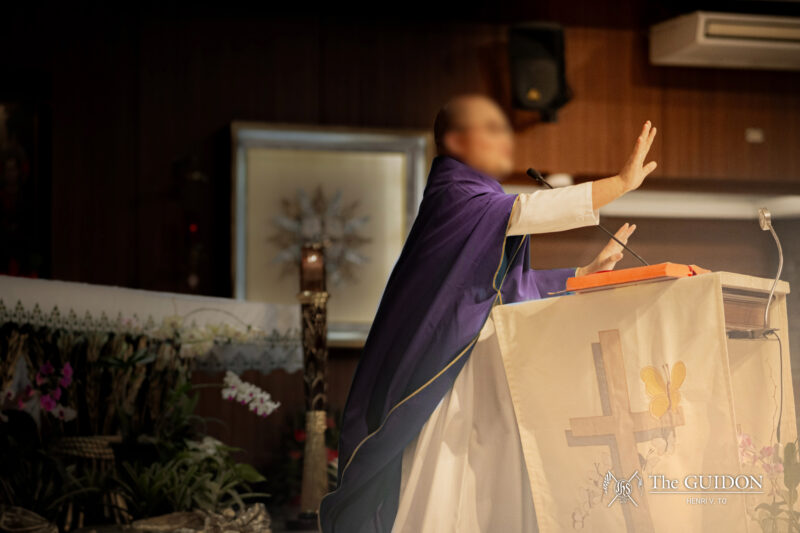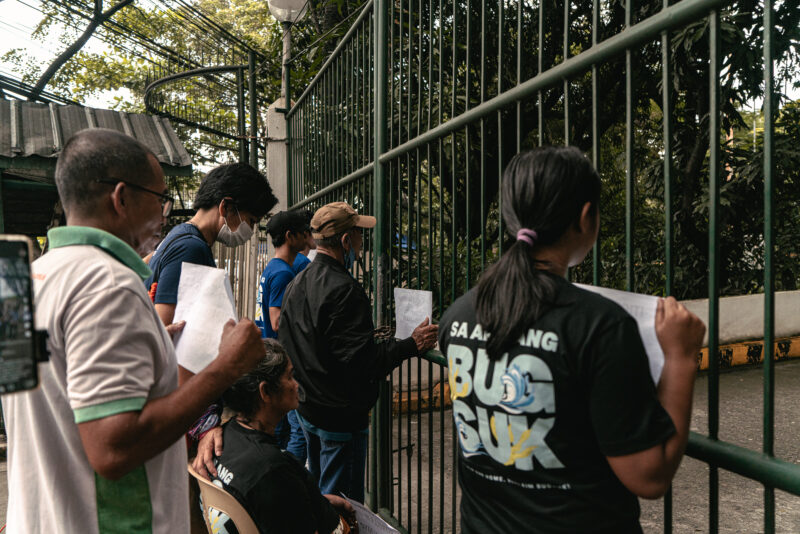Dwindling in visitors and sustenance, the Manila Chinese Cemetery has people like Jemma and Maw striving to keep its beauty and syncretism alive.
IN THE Manila Chinese Cemetery, the dead live extravagantly. Boasting big mausoleums with oil paintings, restrooms, and caretakers, the expansive cemetery is a sanctuary for the dead and a place for solace and silence for the living. Home to diverse and grandiose architecture, the Manila Chinese Cemetery strives to preserve a decades-long Chinese-Filipino heritage by simply keeping its doors open.
Ate Maw, the caretaker
Ate Maw* has been a caretaker since 1964.
As she washes her clothes in a basin, Ate Maw shares her experiences as a caretaker. Clocking in at 6:30 AM every day, she cleans mausoleums—mostly for her Chinese clients—for under Php 500 per mausoleum, until 6:30 PM.
Lugging around buckets of water from her cart, Ate Maw complains about the absence of running water in the cemetery. In the past, each mausoleum had running water. However, families of the bereaved no longer pay for it anymore, leaving her and other caretakers no choice but to pump water using the rusted deep wells that surround the cemetery.
In her 59 years of work, Ate Maw claims she has never gotten scared. Despite hearing about paranormal sightings by her children, she has not encountered a single ghost in the cemetery. Sometimes, when she is too lazy to go home, she sleeps beside the mausoleums that she cleans. In the cemetery’s silence, she lies on the concrete floor trying to fall asleep for the next day, as the dead lay in extravagant refuge.
Jemma, the administrator
Originally, Jemma* was not eyeing to manage the cemetery. However, when her father-in-law died, she and her husband assumed the role as administrators.
Paintings of plants and a huge, colorful map of the cemetery adorned the walls of Jemma’s office. The map was a trapezoidal figure that depicted 54 hectares of land.
Jemma grew up living in the cemetery. When she was a kid, lights would surround the cemetery every November 1 as laughter and enthusiasm filled the air. She described it as a fiesta, like a reunion of sorts. It seemed like the dead had a purpose: bringing the living together in spite of familial quarrels and differences.
“Pero ‘yun ‘yung [nangyayari] noong araw ko (But that was what happened during my day),” she adds. Now, the cemetery is filled with a dreary silence, longing for its bright lights and jovial reunions.
Tsinoy roots
The Manila Chinese Cemetery is one of the oldest cemeteries in the Philippines. It was founded in the 1850s, at a time when intermarriages were happening between the Chinese and Indios. Unlike other major cemeteries in the north of Manila, the Chinese cemetery housed many denominations, including Taoist, Buddhist, and Christian burials.
Throughout the years, this cemetery has undergone many changes. Architecturally, the Chinese cemetery has witnessed many additions, inspired by construction from the east and west, ranging from Chinese-inspired pagodas to British brutalist designs.
During the mid-19th century, creating grandiose mausoleums and tombs was a way for the upper- and middle-class Chinese mestizos to express their recently found status and wealth. Tsinoy roots were built upon the syncretization of religion and culture between the Filipino and Chinese, forming the modern Filipino-Chinese.
Dwindling in its visitors and sustenance, the Manila Chinese Cemetery is a gateway to the past and recent. It possesses diverse architecture and deep connections with a tight-knit and highly integrated Tsinoy community.
Uncleaned, unkempt, and untouched
Every year, over a hundred people transfer their loved ones abroad and to other cemeteries. “Parang Exodus, naglilipatan [na] sila (It’s like an Exodus, they are all transferring their loved ones),” Jemma alludes. “Hindi natin masabi, baka maging ano na—ghost town (We can’t say, this cemetery might become a ghost town).”
Despite the many transfers, these abandoned mausoleums and shattered cement walls provide temporary shelter for grave cleaners and dwellers alike during the outpours of rain and ultimately, the harshness of life. Ate Maw shares that, by the grace of God, there are still kind people. Whenever her clients pass by, they would often tip her a few hundred pesos. Such an amount for her was enough to get by. There are also times that a nearby restaurant would offer her leftover food for dinner, allowing her to save for multiple meals.
People like Jemma and Ate Maw keep this place alive. Despite a lack of income and interest from visitors, Jemma hopes to maintain the cemetery and create more gardens. Without funds however, her hands are tied, leaving the majority of the cemetery uncleaned, unkempt, and untouched. Although the Manila Chinese Cemetery slowly becomes a ghost town, it continues to be haunted by the warmth of memories past.
*Editor’s Note: The interviewees’ names have been changed at their request to protect their identity and privacy.







